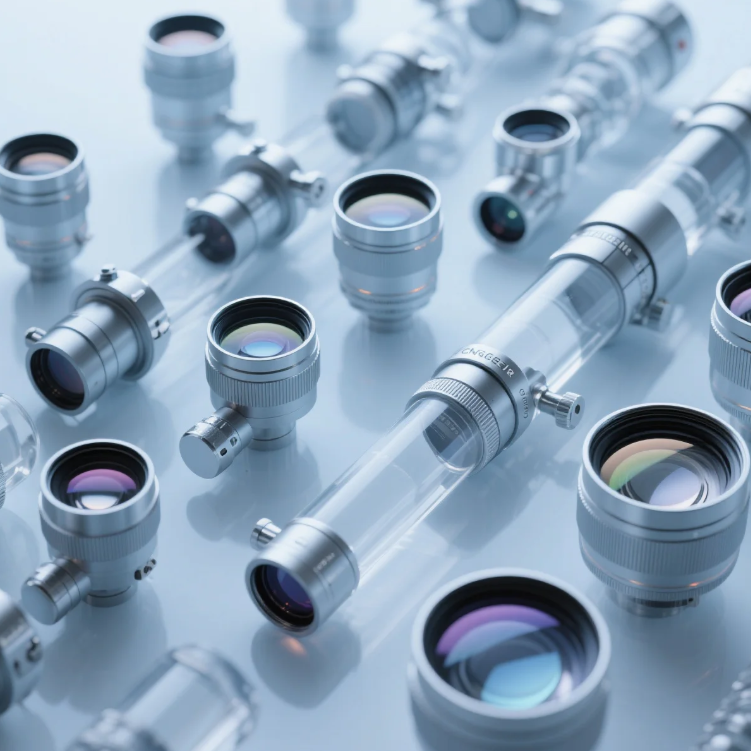Optical materials play a crucial role in ensuring that light behaves as intended within various optical systems. One of the fundamental characteristics of these materials is their refractive index (n), which is a measure of how much light slows down and bends when it enters these materials from a vacuum. The refractive index is crucial in understanding how light will interact with different media and is derived using the following equation:
n=cvn = \frac{c}{v}n=vc
where:
ccc is the velocity of light in a vacuum,
vvv is the velocity of light in the new medium.
In a vacuum, light travels at its fastest speed, approximately 299,792 kilometers per second, and its refractive index is defined as 111. This standard is used to compare the refractive indices of other materials. For instance, borosilicate crown, a commonly used optical material, has a refractive index of 1.5171.5171.517. This means light travels 1.5171.5171.517 times slower in borosilicate crown compared to a vacuum. A higher refractive index indicates that light bends more due to a greater deceleration, which helps in achieving specific optical designs.
Optical designers choose materials based on their ability to manipulate light. When designing multi-element systems, understanding the refractive indices of each material is crucial. The international 6-digit code used to identify optical materials includes the first three digits as the refractive index. For borosilicate crown, which has a 6-digit code of 517-642, the first three digits (517) represent its refractive index value.
Optical dispersion (Vd) is another key factor in optical system design. While the refractive index describes the rate of light’s deceleration, dispersion measures how different wavelengths of light bend differently. This is evident in the phenomenon where white light passing through a prism splits into different colors, each bending at slightly different angles due to varying decelerations.

Materials vary widely in their dispersion properties. Some materials are designed to maximize dispersion, useful for creating vibrant color effects, while others are designed to minimize dispersion to ensure clear, crisp imaging. For example, in the context of a two-element telescope design, if the refractive indices and dispersion values are not carefully managed, the image seen through an eyepiece may exhibit chromatic aberration, a type of optical distortion.
When designing telescopes, optical materials must be carefully chosen to minimize chromatic aberration. Telescopes, which rely on multiple lenses to form and focus images, can suffer from color fringing if the optical components don’t perfectly align with the different wavelengths of light. This misalignment can result in halo effects around objects, similar to what was described earlier. Advanced optical materials, such as those from CNGEIR, help in reducing these issues by providing precise control over light dispersion.
Optical materials are not just limited to telescopes but are also used in measurement tools like infrared optical thermometers. These thermometers use specialized optical lenses to accurately measure human body temperature, showcasing the versatility and importance of advanced optical materials.

CNGEIR is a leading optical solutions provider in China, offering a wide range of advanced optical materials and products. Our aspheric optical lenses and optical domes are used in a variety of applications, from medical equipment to scientific instruments. Our optical materials, such as infrared optical and sapphire optical lenses, are engineered to meet high-performance standards.
CNGEIR is known for its ability to provide custom optical solutions. Our team of experts works closely with clients to design and manufacture optical components tailored to their specific needs. From custom aspheric lens manufacturing to optical windows and optical assemblies, we offer comprehensive solutions.
CNGEIR’s commitment to providing high-quality optical materials and advanced optical solutions underpins our position as a leading supplier in the industry. Whether you need advanced optical materials, aspheric lenses, or custom optical components, CNGEIR has the expertise and resources to meet your requirements. We stand ready to provide solutions that can transform your optical designs and applications, ensuring outstanding performance and reliability.
 Call us on:
Call us on:  Email Us:
Email Us:  No.9 Zhongxing East Road, Lishui Economic Development Zone, Nanjing, Jiangsu, China
No.9 Zhongxing East Road, Lishui Economic Development Zone, Nanjing, Jiangsu, China